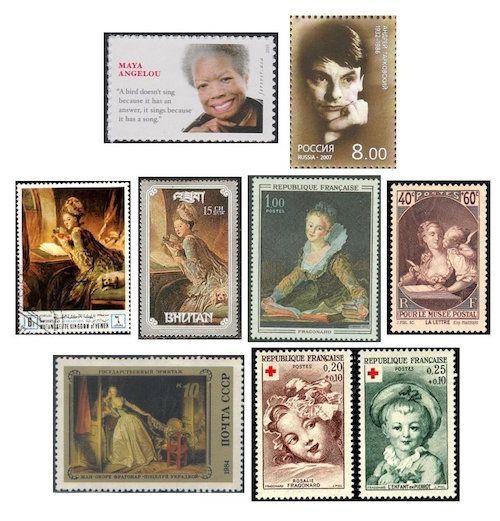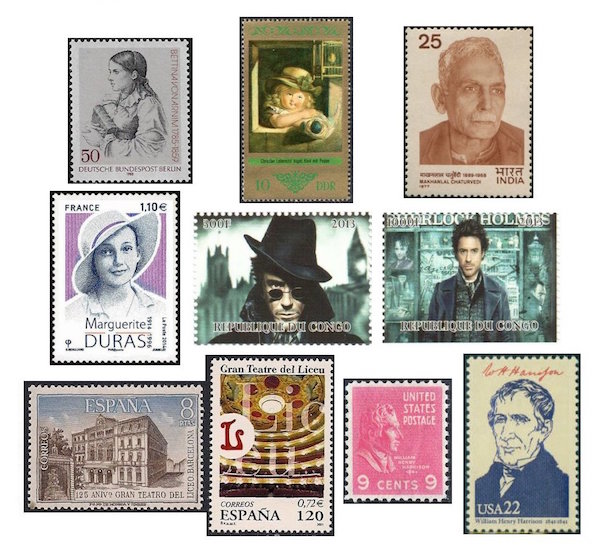The Arts on the Stamps of the World — April 4
An Arts Fuse regular feature: the arts on stamps of the world.

By Doug Briscoe
Three French painters and three women writers (one of them Maya Angelou) grace our page today along with the great Russian film director Andrei Tarkovsky and three other artists from Germany, India, and the United States.
The late Maya Angelou was born Marguerite Annie Johnson on April 4, 1928. Her remarkable life touched on many aspects of the human condition, not excluding some of the decidedly less palatable ones. One positive facet of her childhood was that her grandmother, who cared for the three- to seven-year-old Maya, more than held her own financially during the Depression. But the traumas of child abuse and murder left Maya literally mute for years, though it seems she found solace in books; she worked in the sex trade, married a Greek man, took dance instruction and formed a team with Alvin Ailey, divorced, toured Europe in a production of Porgy and Bess; met James Baldwin in Paris, studied languages, appeared in a movie, met Dr. Martin Luther King Jr. and went into civil rights activism, acted in a play with Abbey Lincoln, Roscoe Lee Brown, James Earl Jones, Louis Gossett, Godfrey Cambridge, and Cicely Tyson; edited periodicals in Cairo and Ghana, became friendly with Malcolm X, sang in Hawaii, wrote plays in Los Angeles; and that takes us up only to the mid 1960s! What a biopic is there, my countrymen! The stamp has its own story. The quotation cited on the stamp did not originate with Angelou, though she is known to have used it from time to time, and it was once attributed to her in a speech by President Barack Obama. It seems, though, that the actual author was Joan Walsh Anglund—it appears in her 1967 book, A Cup of Sun.

Andrei Tarkovsky (4 April 1932 – 29 December 1986) is held to be one of the greatest of film auteurs, despite having made only seven feature films. Tarkovsky came of the Polish and Russian nobility. His father was a poet and translator. He studied piano and art and came down with tuberculosis after the war. His first student film was a 1956 short based on Hemingway’s story “The Killers”. (Khrushchev’s Soviet Union was opening up to some Western influences, but I couldn’t find out whether Tarkovsky had seen the 1946 Robert Siodmak version. I would guess not.) He made only two more shorts before his powerful and beautiful masterpiece Ivan’s Childhood (1962). Since the complete list is regrettably so short, we can provide it in full within a brief space: Andrei Rublev (1966), Solaris (1972), Mirror (1975), Stalker (1979), Nostalghia (1983), and The Sacrifice (1986). He also staged a 1983 performance of Mussorgsky’s opera Boris Godunov at the Royal Opera House in London, with Claudio Abbado conducting.
Whoever wrote the Wikipedia article on Jean-Honoré Fragonard (4 April 1732 – 22 August 1806) captured the essence of the man’s style, describing it as marked by “facility, exuberance, and hedonism…conveying an atmosphere of intimacy and veiled eroticism.” The Fragonard stamps I found are a bit more innocent, with a couple of them being portraits of children. Somewhat more typical, I suppose, is his famous 1767 confection The Swing, for which I was unable to find a stamp. I did find two for The Love Letter (1770), which hangs in the Metropolitan Museum of Art in New York, one for L’ Étude (c1769) in the Louvre, and one (next row) from Russia of The Stolen Kiss (late 1780s) in the Hermitage. Young Fragonard studied with Boucher and Chardin, winning the Prix de Rome as early as 1752. In Rome he studied further with Charles-André van Loo, returning to Paris in 1761. His wife, Marie-Anne Gérard, was a painter of miniatures, and their son, Alexandre-Évariste Fragonard, was a painter and sculptor.
Like Fragonard, Pierre-Paul Prud’hon (1758 – February 16, 1823) went to Italy in his twenties for study and, on his return to Paris, was much celebrated as a painter for the well-to-do and the well-placed, the only difference being Fragonard’s ancien régime vs. Prud’hon’s Republic and Empire. He painted Napoleon’s Josephine, for example. But he also did genre pieces like Children With a Rabbit, as seen on a Vietnamese stamp, and specialized in chiaroscuro nudes, as in his Study for the Dream of Happiness (Étude pour la rêve du bonheur) and the array of diverting nudes seen on the souvenir sheet from the Congo.

Our third French painter for the day is Maurice de Vlaminck (4 April 1876 – 11 October 1958). Unlike the other two he was actually born right in Paris and as a child studied violin with his father, turning to painting in his later teens, though he earned a living playing violin in the evenings. (The lower right stamp on the sheet from Guinea superimposes a violin over Vlaminck’s Barges on the Seine of 1905-06.) He became associated with the Fauves and would later attack Picasso for what Vlaminck saw as the dead end of Cubism. Among the stamps are one of his many still lifes and, at upper right, Landscape of La Creuse, c.1910.
Bettina von Arnim, the sister of Clemens Brentano and the wife of Achim von Arnim, led a life as extraordinary in some respects as that of Maya Angelou—the same multifaceted artistic expression and the same contact with the most remarkable people of her time. She knew Goethe and Beethoven and was active as a writer, artist, composer (she is said to have been the first to set any of Hölderlin’s poems to music), singer, publisher, and activist who embraced socialism and wrote polemics against antisemitism. Born Elisabeth Catharina Ludovica Magdalena Brentano on 4 April 1785, she died aged 73 on 20 January 1859.
German painter and art theorist Christian Leberecht Vogel (4 April 1759 – 6 April 1816) was born and died in Dresden. Hailed as a child prodigy by the painter Zeissig, he attended the Dresden Art Academy from the age of nine. After working for a nobleman in Wildenfels, Vogel returned to Dresden for a professorship at the academy. A charming garden house built for him there still stands. Vogel was known for his pictures of children, as exemplified on the East German stamp by his Child With Doll (1815). He was the father of the somewhat better known painter Carl Christian Vogel.
A schoolmaster from the age of 16, it’s no surprise that Makhanlal Chaturvedi (4 April 1889 – 30 January 1968) came to be called “Panditji”. He took up his pen as a poet and served social justice as a writer, journalist, and editor who paid for his outspokenness with several bouts in jail during the Raj and continued his activism after independence. Chaturvedi is also seen as an important contributor to the Chhayavaad (Neo-romantic) movement of Hindi literature. A festival in his name has been held in Jabalpur, Madhya Pradesh since 1987.

Our third and last female polymath today is Marguerite Duras, born Marguerite Donnadieu on this day in 1914. Her talents manifested themselves in many novels, plays, essays, and films. She was born and grew up in what was then French Indochina, returning to her parents’ homeland of France when she was 17. During the war she worked for the Resistance while ostensibly serving the Vichy Government. Her husband was taken to Buchenwald and barely survived the ordeal. She published the first of her many novels in 1943. Her best known work was the screenplay for the 1959 film Hiroshima mon amour, but she also wrote the semi-autobiographical L’Amant (The Lover, 1984), which won the Goncourt Prize and was also made into a film in 1992, and she directed some eighteen films of her own. Marguerite Duras died on 3 March 1996.
Happy birthday to Robert Downey Jr. (born April 4, 1965). I hate the obnoxious Iron Man movies, but I do think Downey is hugely gifted. A sheet of Sherlock Holmes stamps (the Guy Ritchie one from 2009; I couldn’t sit through it) was issued by the Congo in 2013. (Two other actors, though stampless, are I think deserving of mention. The late Peter Vaughan [born Peter Ewart Ohm; 4 April 1923 – 6 December 2016] was a wonderful character actor whose face is very well known from his extensive work in film and television, most recently noted for his portrayal of the wise and kindly Maester Aemon in Game of Thrones. Another fine actor born on this day was Anthony Perkins [1932 – September 12, 1992]; hard to believe he’s been gone for 25 years!)

Also, today is the 170th anniversary of the opening (4 April 1847) of the Gran Teatre del Liceu opera house in Barcelona.
I suppose it will be common knowledge all over social media, for reasons that should be self-explanatory, that it was on this day in 1841 that William Henry Harrison died of pneumonia after serving just 31 days as President of the United States. His record of shortest-serving President appears secure for some time longer. (These two US Harrison stamps come from complete sets of US Presidents issued in 1938 and 1986.)
A graduate of the University of Massachusetts with a B.A. in English, Doug Briscoe worked in Boston classical music radio, at WCRB, WGBH, and WBUR, for about 25 years, beginning in 1977. He has the curious distinction of having succeeded Robert J. Lurtsema twice, first as host of WGBH’s weekday morning classical music program in 1993, then as host of the weekend program when Robert J.’s health failed in 2000. Doug also wrote liner notes for several of the late Gunther Schuller’s GM Recordings releases as well as program notes for the Boston Classical Orchestra. For the past few years he’s been posting a Facebook “blog” of classical music on stamps of the world, which has now been expanded to encompass all the arts for The Arts Fuse.

What a beautiful day!